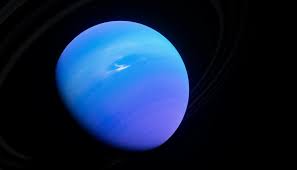
Introduction
Within the vastness of our solar system, Uranus is a singular planet whose features still confound and fascinate scientists. This far-off ice giant’s radiation belts are among its most intriguing features. These radiation-heavy zones, which are frequently eclipsed by Jupiter’s and Saturn’s, are essential in forming Uranus’s environment. Knowing these radiation belts will help us better understand the mechanics of our solar system in addition to helping us explore Uranus. This paper explores the unusual significance of space “traffic jams” in the radiation belts surrounding Uranus, offering a thorough explanation of the underlying mechanics and their wider consequences.
The Nature of Uranus’ Radiation Belts
Composition and Structure
High-energy particles trapped by the planet’s magnetic field, mostly protons and electrons, make up Uranus’ radiation belts. These belts have an Earth-like structure, but because of Uranus’ peculiar magnetic field orientation and axial tilt, they have special characteristics. There are two primary regions inside the radiation belts.:
- Inner Radiation Belt: This region is closer to Uranus and contains highly energetic particles. The inner belt is relatively stable and less affected by external factors such as solar wind.
- Outer Radiation Belt: Located further from the planet, the outer belt is more dynamic and influenced by the interaction between Uranus’ magnetic field and the solar wind. This region is where space ‘traffic jams’ play a significant role.
Unique Magnetic Field Dynamics
Unlike Earth, where the magnetic field is largely aligned, Uranus is tilted at an angle of around 59 degrees from its rotating axis. Because of this tilt, the magnetosphere becomes complicated and asymmetrical, with deformed radiation bands that exhibit varying intensities in different areas. Because of the special orientation of the magnetic field, ‘pockets’ emerge within the radiation belts where particles gather and produce strong radiation zones, similar to space traffic jams.
The Role of Space ‘Traffic Jams’
Mechanisms Behind Particle Accumulation
The interaction of charged particles from the solar wind with the magnetic field of Uranus causes “traffic jams” in space within its radiation belts. These particles are directed into particular areas where the magnetic field lines converge when they approach Uranus’ magnetosphere. High radiation density regions are produced when the particles are trapped in small areas due to this convergence.
The rotating dynamics of Uranus worsen these “traffic jams” even further. The magnetosphere wobbles in its interaction with the solar wind due to the planet’s rotation on its side. The periodic compression and expansion of the radiation belts caused by this swaying effect causes the particles to congregate in specific places, raising the radiation levels.
Impact on Spacecraft and Missions
The intense radiation in these space ‘traffic jams’ poses significant challenges for spacecraft missions to Uranus. Any mission planning to explore the planet must account for these hazardous regions to avoid damage to sensitive instruments. Understanding the distribution and behavior of these traffic jams is crucial for the safe navigation of spacecraft in Uranus’ vicinity.
Broader Implications for Planetary Science
Comparative Analysis with Other Planets
The study of Uranus’ radiation belts provides valuable insights into the broader field of planetary science. By comparing Uranus’ radiation belts with those of other planets, such as Jupiter and Saturn, scientists can better understand the factors that influence the formation and dynamics of radiation belts across the solar system. The unique characteristics of Uranus’ belts challenge existing models and encourage the development of new theories about magnetospheric dynamics.
Insights into Space Weather and Astrobiology
Uranus’ radiation belts also have implications for space weather—the study of conditions in space that can affect Earth and other celestial bodies. By studying the radiation belts of Uranus, scientists can gain insights into how space weather phenomena, such as solar storms, interact with planetary magnetospheres. Additionally, the harsh radiation environment around Uranus raises questions about the potential for life on its moons, as intense radiation could significantly impact the habitability of these bodies.
Future Research and Exploration
Potential Missions to Uranus
Given the unique and complex nature of Uranus’ radiation belts, future missions to the planet are essential for advancing our understanding of this enigmatic ice giant. These missions would focus on mapping the radiation belts in greater detail, studying the magnetic field dynamics, and exploring the interactions between the belts and Uranus’ moons. Such missions would not only deepen our knowledge of Uranus but also contribute to our understanding of planetary magnetospheres in general.
Technological Challenges and Innovations
Exploring Uranus’ radiation belts presents several technological challenges, particularly in terms of shielding spacecraft from intense radiation. Innovations in spacecraft design, such as advanced radiation-hardened materials and protective shielding, will be crucial for the success of future missions. Additionally, developing new instruments capable of withstanding the harsh conditions in Uranus’ magnetosphere will be vital for obtaining accurate data.



